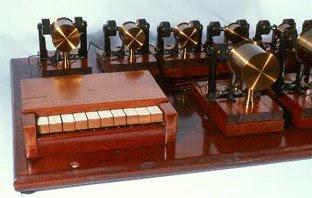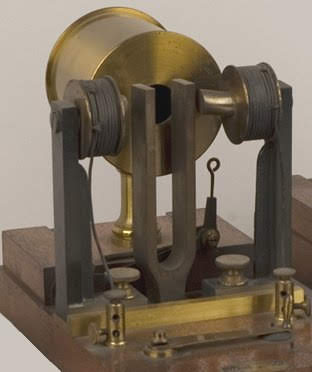Helmholtz showed that the timbre of musical notes, and vowel sounds, is a result of their complexity: just as seemingly-pure white light actually contains all the colors of the rainbow, clearly defined musical notes are composed of many different tones. If you play the A above middle C on an organ, for example, the sound you hear has a clearly defined "fundamental" pitch of 440Hz. But the sound does not only contain a simple "fundamental" vibration at 440Hz, but also a "harmonic series" of whole number multiples of this frequency called "overtones" (i.e., 880Hz, 1320Hz, 1760Hz, etc.). Helmholtz proved, using his synthesizer, that it is this combination of overtones at varying levels of intensity that give musical tones, and vowel sounds, their particular sound quality, or timbre.
This ingenious device was the very first sound synthesizer: a tool for studying and artificially recreating musical tones and the sounds of human speech.
Background
Suppose I sing the word 'car' and then on the same note sing 'we'. The two vowel sounds will be similar in so far as they have the same pitch yet they have a clearly distinct sound quality, or timbre. What is it that accounts for this difference, and the timbres of musical sounds in general? Helmholtz set out to answer this very question in the mid 19th century, building on the work of the Dutch scientist Franz Donders (1818-1889).
Complex tones

How the synthesizer works

Helmholtz's apparatus uses tuning forks, renowned for their very pure tone, to generate a fundamental frequency and the first six overtones which may then be combined in varying proportions. The tuning forks are made to vibrate using electromagnets and the sound of each fork may be amplified by means of a Helmholtz resonator with adjustable shutter operated mechanically by a keyboard.
By varying the relative intensities of the overtones, Helmholtz was able to simulate sounds of various timbres and, in particular, recreate and understand the nature of the vowel sounds of human speech and singing. Vowel sounds are created by the resonances of the vocal tract, with each vowel defined by two or three resonant frequencies known as formants. When we say or sing 'a' (as in 'had'), for instance, the vocal tract amplifies frequencies close to 800Hz, 1800Hz and 2400Hz amongst others. When we require a different vowel sound, the muscles of the throat and mouth change the shape of the vocal tract, producing a different set of resonances.
Torben Rees
Torben Rees, 'Helmholtz's apparatus for the synthesis of sound: an electrical 'talking machine'', Explore Whipple Collections, Whipple Museum of the History of Science, University of Cambridge, 2010



